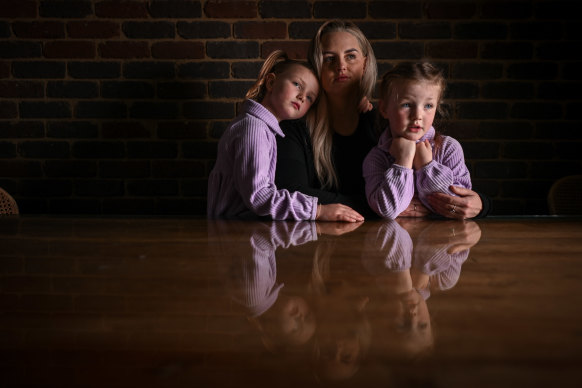This was published 9 months ago
New laws protect 600,000 workers from deadly dust, but they come too late for Joanna
Since being diagnosed with silicosis following her time working on a quarry site, mother of two Joanna McNeill says she’s scared to live in the present.
“My mental health is an ongoing battle because I live in the unknown. I’m scared every time I get sick. I live in fear,” she said.
McNeill was diagnosed with the progressive and debilitating occupational lung disease in 2019 after spending six years working from a portable office at a crushing plant in Melbourne’s east.

Joanna McNeill and her daughters Matilda, 8, and Charlee, 6. Joanna contracted silicosis after working in admin at a quarry.Credit: Eddie Jim
Silicosis is caused by the inhalation of crystalline silica dust, which is present in many types of rocks.
McNeill was not given any form of protection from the dust, which can cause lung cancer, tuberculosis, kidney disease and chronic obstructive pulmonary disease.
New national laws that take effect today give workers the right to demand multiple safety control measures, such as PPE, water suppression, on-tool extraction systems and local exhaust ventilation systems.
Workers can also demand a silica risk control plan from their employer in high-risk environments.
It follows the national ban on the use, supply and manufacture of engineered stone, a popular bathroom and kitchen benchtop product that contains silica, introduced in July.
The regulations were triggered by a joint Herald and 60 Minutes investigation which revealed an increase in silicosis cases among workers. A subsequent report by Safe Work Australia found there was no safe level of dust emitted when engineered stone slabs were cut.
It’s estimated the additional laws, which have been in place in Victoria for the past year and extend protections to those working with other materials, will protect a further 600,000 workers from the deadly dust.
‘A step in the right direction’
McNeill said the legislation was a “little win”.
“It’s a small step in the right direction … but it will be up to Safe Work to really knuckle down and enforce it,” she said.
Australian Workers’ Union national secretary Paul Farrow said the union would be watching to make sure that employers follow the rules from day one.
“This dust is present in hundreds of worksites across Australia, and employers have turned a blind eye to the health and safety of their workers,” he said.
“We have members right now in our nation’s major cities and regional areas building crucial public infrastructure for Australians to enjoy … now these hardworking men and women can enjoy protections at work against this deadly dust.”
The laws were agreed to by state and territory workplace safety ministers earlier this year. However, Western Australia has chosen to exclude mine sites from the regulations, arguing that existing work health and safety laws address the issue.
A spokesperson for the federal Department of Employment and Workplace Relations said the laws were the result of carefully considered advice from Safe Work Australia, which would monitor their effectiveness.
The laws will be enforced by Commonwealth, state and territory workplace health and safety regulators.
The Morning Edition newsletter is our guide to the day’s most important and interesting stories, analysis and insights. Sign up here.